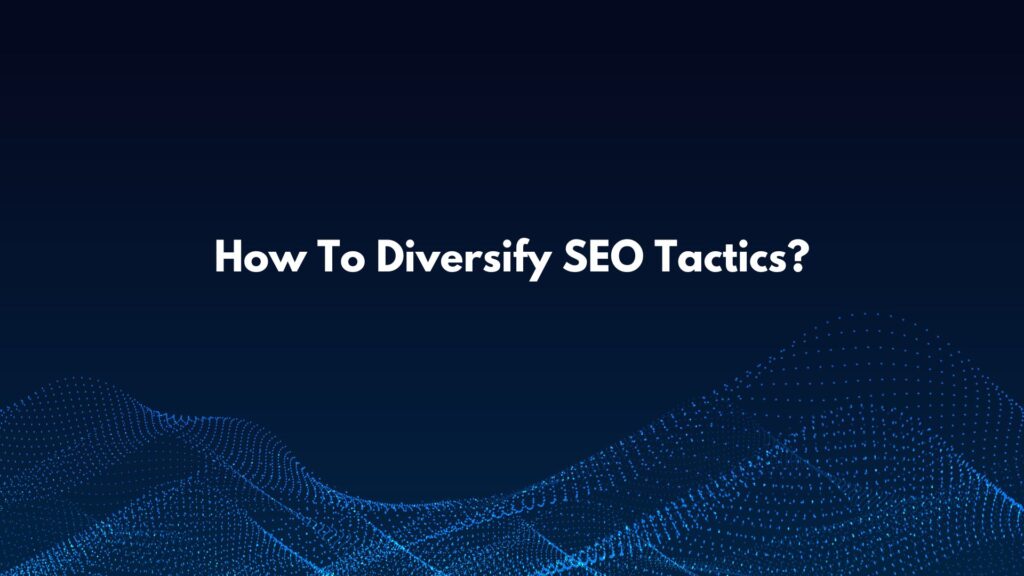How To Diversify Your SEO Strategy?
So, you’ve got your SEO basics down. You understand keyword targeting, you’ve optimized your title tags, and you know that links matter. But you’ve also probably noticed the SEO landscape is anything but static. Algorithm updates roll out constantly, search behavior evolves (hello, AI search!), and competitors are always stepping up their game.
Relying too heavily on a narrow set of tactics – say, just focusing on a few high-volume keywords or one specific link-building technique – leaves you vulnerable. It’s the classic “all eggs in one basket” scenario. Diversification isn’t just a nice-to-have; it’s crucial for building a sustainable, high-performing, and future-proof SEO strategy.
Let’s explore how to strategically broaden your SEO toolkit beyond the fundamentals:
1. Evolve Your Keyword Strategy: Intent, Semantics & Clusters
Basic keyword research is just the starting point. To truly diversify, you need to think more holistically:
- Master Search Intent: Go beyond just keyword volume and difficulty. Rigorously categorize keywords by intent:
- Informational: (e.g., “how does SEO work?”, “what is E-E-A-T?”) – Target with blog posts, guides, and definitions.
- Navigational: (e.g., “Google Search Console login”) – Usually brand-related, ensure easy site navigation.
- Commercial Investigation: (e.g., “best SEO tools comparison,” “Mailchimp alternatives”) – Target with comparison pages, reviews, and detailed feature lists.
- Transactional: (e.g., “buy SEO audit,” “hire SEO agency”) – Target with service/product pages, clear calls-to-action.
- Why diversify? Targeting different intents captures users at various stages of the buyer’s journey, expanding your reach.
- Embrace Semantic Search & Topic Clusters: Google understands context, not just exact-match keywords. Structure your content around core topics (pillar pages) supported by related subtopics (cluster content).
- Pillar Page: A comprehensive guide on a broad topic (e.g., “The Ultimate Guide to Technical SEO”).
- Cluster Content: Detailed articles on specific aspects, linking back to the pillar (e.g., “How to Optimize Crawl Budget,” “Implementing Hreflang Correctly,” “JavaScript SEO Best Practices”).
- Why diversify? This demonstrates topical authority to Google (aligning with E-E-A-T) and improves the internal linking structure.
- Mine Question Keywords & Zero-Click Opportunities: Use tools (AnswerThePublic, AlsoAsked, Ahrefs’ Questions report) to find questions your audience asks. Optimize content to answer these questions directly, aiming for Featured Snippets, “People Also Ask” boxes, etc., even if they don’t always result in a click (they build brand visibility and authority).
2. Diversify Content: Formats, Funnels & Frameworks
Your content needs to do more than just exist; it needs to serve different purposes and audiences.
- Map Content to the Funnel: Create assets specifically for:
- Top of Funnel (TOFU): Awareness stage – Blog posts, infographics, videos, social media content.
- Middle of Funnel (MOFU): Consideration stage – Case studies, whitepapers, webinars, comparison guides, and detailed how-tos.
- Bottom of Funnel (BOFU): Decision stage – Product/service pages, free trials, demos, testimonials, pricing pages.
- Why diversify? Nurtures leads effectively through their journey.
- Vary Content Formats: Go beyond text. Invest in video (tutorials, interviews), podcasts, interactive tools (calculators, quizzes relevant to your niche), data studies, and compelling infographics. Repurpose core content across formats (e.g., a data study becomes a blog post, infographic, video summary, and social snippets).
- Prioritize E-E-A-T: Especially crucial post-Helpful Content and core updates. Ensure your content demonstrates Experience, Expertise, authority, and Trustworthiness. This involves author bios, citing sources, showcasing credentials, updating content regularly, and ensuring factual accuracy.
- Why diversify efforts here? Google explicitly rewards content that demonstrates strong E-E-A-T signals, directly impacting rankings, especially for YMYL (Your Money Your Life) topics.
3. Advanced On-Page & Technical Optimization
Basic on-page SEO is table stakes. Diversify by refining the user and crawler experience:
- Strategic Internal Linking: Move beyond random linking. Use internal links to distribute PageRank strategically, support cornerstone content (pillar pages), guide users toward conversions, and help search engines discover deeper pages. Audit and improve your internal link structure regularly.
- Granular Structured Data (Schema Markup): Implement relevant schema beyond the basics (Article, Breadcrumb). Consider Product, Review, FAQ, HowTo, VideoObject, LocalBusiness, Event, JobPosting, etc. Use JSON-LD format. This helps Google understand content context deeply and can unlock rich results.
- Optimize for Core Web Vitals (CWV) & Page Experience: This isn’t just about speed. Dig into:
- LCP (Largest Contentful Paint): Optimize images (WebP format, correct sizing), defer non-critical resources, and improve server response time.
- FID/INP (First Input Delay / Interaction to Next Paint): Minimize main thread work, break up long tasks, and reduce JavaScript execution time.
- CLS (Cumulative Layout Shift): Specify image/video dimensions, reserve space for ads/embeds, and avoid non-composited animations.
- Why diversify focus here? Page experience is a confirmed ranking factor, directly impacting user satisfaction and SEO performance.
- Crawl Budget Optimization: This is Especially for larger sites. Ensure Googlebot efficiently crawls your important pages. Use
robots.txtstrategically (disallow low-value sections), manage URL parameters, improve site speed, fix broken links/redirect chains, and submit accurate XML sitemaps. Consider log file analysis to see how Googlebot interacts with your site. - JavaScript SEO: If your site relies heavily on JavaScript, ensure that the content is properly rendered and indexable. Implement server-side rendering (SSR) or dynamic rendering where necessary.
4. Diversify Your Off-Page Strategy: Beyond Standard Link Building
A natural, authoritative backlink profile is diverse. Relying solely on guest posts is limiting and potentially risky.
- Vary Link Acquisition Tactics: Explore:
- Digital PR: Create compelling stories, data, or campaigns that earn media mentions and high-authority links naturally.
- Resource Page Link Building: Find pages listing resources in your niche and pitch your valuable content.
- Unlinked Brand Mention Reclamation: Monitor mentions of your brand name that don’t link back, and reach out to request a link.
- Broken Link Building: Identify broken external links on relevant sites and suggest your content as a replacement.
- Strategic Partnerships: Collaborate with complementary businesses for cross-promotion and link opportunities.
- Niche Edits/Link Insertions (Use cautiously) requesting links within existing relevant content on other sites.
- Focus on Link Quality & Relevance: Prioritize links from authoritative, topically relevant websites over sheer quantity. A few strong links beat hundreds of weak ones.
- Anchor Text Diversification: Avoid over-optimizing with exact-match keywords. Use a natural mix of branded anchors (your brand name), naked URLs (www.seoshaft.com), generic anchors (“click here”), and partial match/semantic anchors.
- Leverage Social Signals & Brand Building: While direct SEO impact is debated, strong social media presence, brand searches, and positive online reputation contribute to overall authority and trustworthiness (E-E-A-T signals) and can indirectly lead to links and traffic.
5. Prepare for Evolving Search Experiences
SEO isn’t just about traditional blue links anymore:
- Voice Search Optimization: Target conversational, long-tail question keywords. Structure content for concise answers (FAQ schema helps). Optimize local listings (many voice searches are local).
- Visual Search Optimization: High-quality, optimized images with descriptive filenames and alt text are key. Consider Google Lens compatibility. Organize products clearly for visual discovery.
- Video SEO: Optimize video titles, descriptions, and tags on platforms like YouTube. Add transcripts and consider video schema. Embed videos strategically on your site.
- AI & Generative Search (SGE): While still evolving (as of early 2025), focus on building strong brand authority, demonstrating first-hand experience (the ‘E’ in E-E-A-T), providing unique insights not easily replicated by AI, and optimizing for “perspectives” and forum-like discussions within search results.
Integrating Your Diversified Strategy
Don’t treat these as isolated silos. A truly diversified strategy integrates these elements:
- Your keyword research informs your content strategy.
- Your content quality (and E-E-A-T) supports link building/Digital PR.
- Technical SEO ensures your great content is crawlable and provides a good user experience.
- On-page optimization (like schema and internal linking) enhances how both users and search engines understand your content.
Conclusion: Build Resilience Through Variety
Diversifying your SEO strategy moves you from chasing specific ranking factors to building a fundamentally strong, authoritative, and user-centric online presence. It requires a broader skillset and a more holistic view, but the payoff is significant: greater resilience against algorithm updates, wider audience reach across different intents and formats, and more sustainable long-term growth.
Audit your current efforts. Identify where you’re overly reliant on one tactic. Then, strategically choose one or two new areas from above to integrate and master. Continuous learning and adaptation are key, but a diversified foundation will serve you well in the ever-changing world of SEO.



